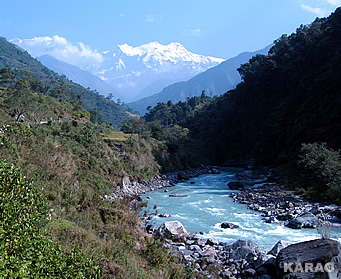 |
Nepal Information |
|
 |
Nepal Information |
|
|
 |
| Trekkings in Nepal |
 |
The
immense contrast in altitude and climatic
conditions in Nepal support an equally spectacular blend of human
settlements and variations in culture, vegetation
types and wildlife. Thus, Nepal offers ecellent trekking
options to visitors, which range from easy walking ecursions to the
strenuous climb of the snowy peaks and present a perfect cultural eperience complement as well. Therefore,
some routes in Nepal are regarded as world-class trekking routes.
Trekking
in Nepal is a big part of the ultimate Himalayan adventure and
a majority of tourists have trekking on their itinerary.
Trekking routes in Nepal vary from simple ones within Kathmandu Valley to some very challenging treks in remote high-altitude areas. The
variation in elevation of many parts of Nepal makes trekking feasible in
certain areas of the country throughout the year. Autumn and spring are
the best trekking seasons in Nepal.
Low elevation treks, such as around
the Kathmandu and Pokhara Valley are also pleasant during winter. Some regions in western Nepal
fall in the rain shadow of the Himalayan
ranges, for instance the upper Kali Gandaki Valley (Muktinath area) and the Dolpa region. These areas offer a very different and eciting
eperience through trekking.
 |
ACTIVITIES |
Everest
region also known as the Khumbu region has been one of the most
important trekking regions
in Nepal. A large number of mountaineers and trekkers are drawn to the Everest region that leads through the Sagarmatha
National Park.
Trekking in the Everest
region starts from Jiri in the Solu Region or from Lukla and reaches Everest Base Camp at an elevation of 5,450 masl. The
round trip takes at least three weeks. Some of the remarkable sites along
the trek include Namche Bazaar, the Tengboche Monastery and Kala
Paththar en route to the Everest Base Camp. This area is abundant in
high-alpine wildlife that include the Himalayan thar, musk deer (Moschus
chrysogaster), pika or mouse hare and rare birds like snow crow, snow pigeon
and pheasant and rhododendron (Rhododendron arboreum), blue pine (Pinus
wallichiana) and fir.
The spectacular beauty of Himalayas together with
these natural and cultural resources attracts thousands of visitors each
year.
 |
| Annapurna
Region harbors peaks such as Annapurna I, II, III and IV. It is
not only popular within Nepal but is also recognized as world class trekking
destination. The trek's major highlights are the ancient mid-western salt
route settlement of Manang, Thorong-La
pass (5,360 m asl) between Nepal and Tibet, Muktinath Temple and the deepest gorge of world, the Kali Gandaki gorge.
Mustang,
or Lo Manthang, the desert plateau is located in the upper valley
of the Kali Gandaki river (Kali
Gandaki Graben). |
|
The
region also offers a trekking route to Machhapuchre Base Camp (MBC)
via famous Gurung settlements such as Ghandruk and Chomrong.
Alpine
meadows, bamboo forests and a variety of trees along with wildlife such
as barking deer, bear, thar, ghoral, Impeyan pheasant (Lophophorus impejanus),
musk deer (Moschus chrysogaster) and blue sheep are the attractions of
the region. It takes at least three weeks to complete the Annapurna Circuit.
A large number of trekkers visit the Annapurna region each year because
it offers several options for trekkers.
Dolpo
Region in West Nepal is located inside the Shey-
Phoksundo National Park, to the north of Dhaulagiri
range. The National Park is home to several plants and wildlife
that includes the rare blue sheep, grey wolf and snow leopard (Uncia uncia).
The view of the Kanjiroba peak, Phoksundo
Lake and Mt. Dhaulagiri are major rewards for a trekker to the Dolpo
region. It can be reached by air from Nepalgunj to Juphal, which is
a four-hour walk from district headquarters of Dunai. It is also possible
to trek to Dunai from Dhorpatan.
Langtang
region offers a trekking route that runs through traditional, ethnic
villages and untouched forests on the way to the peaks of Langtang. The
highlights of this tour include a visit to the Langtang valley, Kyangin
Gompa and the Lirung Glacier. One can also climb the Lang Sisa Peak and visit Lake Gosainkunda. One can catch a bus to Trisuli Bazaar from Kathmandu and from there again
drive down to Dhunche and then to Syabrubesi from where the
trek begins.
| Major Trekking Routes |
 |
Source:
MOPE - State of the Environment/Eco-Tourism/2004
| More
information and pictures |
 |
| 



